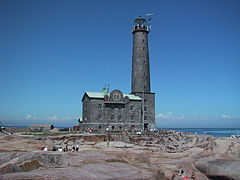Kimitoön
Kimitoön – Kemiönsaari | |
|---|---|
Municipality | |
| Kimitoöns kommun Kemiönsaaren kunta | |
 An old sauna, Sagalund outdoor museum, Kimito, Finland | |
 Location of Kimitoön in Finland | |
| Coordinates: 60°10′N 022°44′E / 60.167°N 22.733°E | |
| Country | |
| Region | Southwest Finland |
| Sub-region | Åboland–Turunmaa sub-region |
| Charter | 2009 |
| Government | |
| • Municipal manager | Erika Strandberg |
| Area (2018-01-01)[1] | |
| • Total | 2,800.99 km2 (1,081.47 sq mi) |
| • Land | 686.91 km2 (265.22 sq mi) |
| • Water | 2,113.94 km2 (816.20 sq mi) |
| • Rank | 123rd largest in Finland |
| Population (2023-12-31)[2] | |
| • Total | 6,462 |
| • Rank | 142nd largest in Finland |
| • Density | 9.41/km2 (24.4/sq mi) |
| Population by native language | |
| • Swedish | 66.2% (official) |
| • Finnish | 30% |
| • Others | 3.7% |
| Population by age | |
| • 0 to 14 | 11.9% |
| • 15 to 64 | 53.3% |
| • 65 or older | 34.8% |
| Time zone | UTC+02:00 (EET) |
| • Summer (DST) | UTC+03:00 (EEST) |
| Website | www.kimitoon.fi |
Kimitoön (Finnish: Kemiönsaari) is a municipality and island of Finland. It was created on 1 January 2009, when the municipalities of Dragsfjärd, Kimito and Västanfjärd were consolidated into a single municipality.
The municipality is located in the Archipelago Sea in the Southwest Finland region. The municipality has a population of 6,462 (31 December 2023)[2] and covers an area of 2,800.99 square kilometres (1,081.47 sq mi) of which 2,113.94 km2 (816.20 sq mi) is water.[1] The population density is 9.41 inhabitants per square kilometre (24.4/sq mi). Actual island is the largest coastal island of Finland with the area of 524 square kilometres (202 sq mi). It is situated in the Southwest Finland region in Western Finland province. The island has a population of 7,500 divided between the two municipalities: Kimitoön and Salo of which Salo is mostly located on the mainland.
Kimitoön is a bilingual municipality with Finnish and Swedish as its official languages. The population consists of 30% Finnish speakers, 66% Swedish speakers, and 4% speakers of other languages.
Politics
[edit]Results of the 2015 Finnish parliamentary election in Kimitoön:[5]
- Swedish People's Party 49.6%
- Social Democratic Party 13.0%
- Left Alliance 9.7%
- True Finns 6.7%
- Centre Party 10.4%
- National Coalition Party 5.4%
- Green League 3.8%
- Christian Democrats 0.8%
- Other parties 0.6%
Gallery
[edit]-
Strömma Canal
-
Restaurant Hotel Villa Felix
-
The Obelisk of Kimito Church
-
Västanfjärd Old Church
See also
[edit]References
[edit]- ^ a b "Area of Finnish Municipalities 1.1.2018" (PDF). National Land Survey of Finland. Retrieved 30 January 2018.
- ^ a b c "Population growth biggest in nearly 70 years". Population structure. Statistics Finland. 26 April 2024. ISSN 1797-5395. Retrieved 29 April 2024.
- ^ "Population according to age (1-year) and sex by area and the regional division of each statistical reference year, 2003–2020". StatFin. Statistics Finland. Retrieved 2 May 2021.
- ^ a b "Luettelo kuntien ja seurakuntien tuloveroprosenteista vuonna 2023". Tax Administration of Finland. 14 November 2022. Retrieved 7 May 2023.
- ^ "Kemiönsaari, tulokset puolueittain". tulospalvelu.vaalit.fi.
External links
[edit]![]() Media related to Kimitoön at Wikimedia Commons
Media related to Kimitoön at Wikimedia Commons
- Municipality of Kimitoön – Official website (in Swedish and Finnish)








Well, that’s interesting to know that Psilotum nudum are known as whisk ferns. Psilotum nudum is the commoner species of the two. While the P. flaccidum is a rare species and is found in the tropical islands. Both the species are usually epiphytic in habit and grow upon tree ferns. These species may also be terrestrial and grow in humus or in the crevices of the rocks.
View the detailed Guide of Psilotum nudum: Detailed Study Of Psilotum Nudum (Whisk Fern), Classification, Anatomy, Reproduction